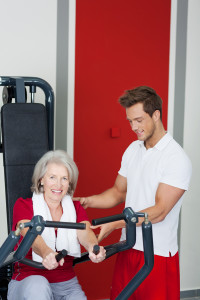 There are many conditions for which exercise can help. Osteoporosis is one such condition, but due to its nature, there are some important factors to consider when putting together an exercise regimen.
There are many conditions for which exercise can help. Osteoporosis is one such condition, but due to its nature, there are some important factors to consider when putting together an exercise regimen.
WARNING
Regardless of your background, make sure you consult with your physician prior to engaging in any sort of exercise regimen. Every case is unique and it is essential that you get your plan approved by your doctor.
What is Osteoporosis?
Osteoporosis is a bone disease caused by a deficiency of calcium in the skeletal system. It can be either the lack of production of new bone tissue, a breakdown of existing bone tissue, or both. It leaves its patients with concerns surrounding fragile bones to which even small actions can cause bones to break.
This can be further complicated by other factors. For instance, osteoporosis is far more common in aging populations, and as such can also be susceptible to arthritis and diminished balance. This means that a fall from an unsupported exercise position can be especially likely to cause injury.
Benefits of Exercise
According to the National Osteoporosis Foundation, exercise can be a great boon to those suffering from the disease. Like muscles, bones also react to exercise. Furthermore, strengthening the supporting muscles also helps the skeletal system better-support your body. A well-rounded exercise regimen can help in many different ways and can have great results that can lead to a better quality of life.
Exercise Focus
For a variety of reasons, it’s essential to look at all different forms of exercise. More functional exercise, like walking and even some versions of cleaning, can help people who might not have a strong background in exercise. But it’s also important to factor in resistance exercises as well which facilitate muscle-building.
Load-bearing Exercise
The National Institutes of Health recommends exercises which force the individual to support their own weight. Walking, hiking, weight training and the like are going to be best. So let’s look at a few of them that you could do every day in order to strengthen your body to fight against osteoporosis.
1. Walking/Hiking/Running
These fit into roughly the same category, depending on your level of fitness. If you haven’t exercised before, a great place to start is simply to walk short distances. Do what you feel like you can and then push yourself to do the same distance the next day. Steadily, as you feel able, increase the lengths of your walks by about 10 percent each week.
For those with a little more experience, hiking and running can be an excellent way to get a little more exercise out of the same amount of time.
2. Weight Training/Resistance Training
Resistance training forces your muscles to expand and contract to overcome a force. This can take many forms. Beginners should be extremely careful with this and might want to seek outside help from a fitness professional coach to assist with form. Proper form will ensure that the likelihood of injury is reduced as much as possible.
In the beginning, resistance bands are a great way to get the benefits of lifting weights without exposing your body to the danger of injury. These bands can be used for many different exercises and more resources can be found here.
For those who are a little more experienced, it can be helpful to advance to weight machines. These provide a safer environment than free weights as they restrict range of motion and often have safeties in place in case the exercise becomes too difficult. Finally, lifting dumbbell and barbell weights are an option for those who have the balance, coordination and experience with form to use these safely.
 4. Circuit Training
4. Circuit Training
Circuit training is an excellent way to train in a modified way that will achieve both the goals of cardio exercise and resistance exercises. Often times, circuits will involve bodyweight exercises or light dumbbells.
It can go either by the clock or by the repetitions in the exercise. For beginners, start by working on the basic exercises, then, as you advance, incorporate them closer together with shorter rests.
Being Careful is Worth It
Injuries, even in healthy people, can cause training breaks. With people suffering from osteoporosis, injuries can be much more complex and take much longer to recover from — if the person can recover at all.
Thus, make sure that you not only approve your exercise regimen with your doctor, but also check in with your doctor periodically to make sure that you are staying safe and seeing improvements.
The benefits by far indicate that exercise can dramatically increase the quality of life for those suffering from osteoporosis. So don’t sit around and just wait for something to change. Get moving and make the change. Your body will thank you!
Jane Curth is the co-founder and CEO of FitFixNow. Helping people on their wellness journey is her passion; Jane has helped clients and students with their diet and fitness struggles for over 20 years.

